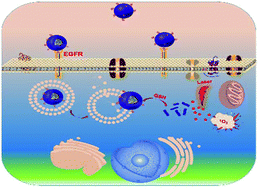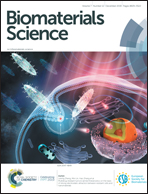A bioactivatable self-quenched nanogel for targeted photodynamic therapy†
Abstract
Photodynamic therapy has attracted significant attention due to its localized treatment advantage. However, the non-specific distribution of photosensitizers and the subsequent potential toxicity caused by sunshine exposure hinder its wide adoption in cancer treatment. To minimize these unwanted effects and improve its efficacy, we developed a bioactivatable self-quenched nanogel, which remains in its inactive state in healthy tissues. Anti-EGFR Affibody decorated nanogels can effectively target head and neck cancer and release activated pheophorbide A in a reducing environment, such as in the tumor stroma and cytoplasm. Consequently, the EGFR targeted nanogel coupled with NIR irradiation alleviates tumor burden by 94.5% while not inducing systemic toxicity.



 Please wait while we load your content...
Please wait while we load your content...